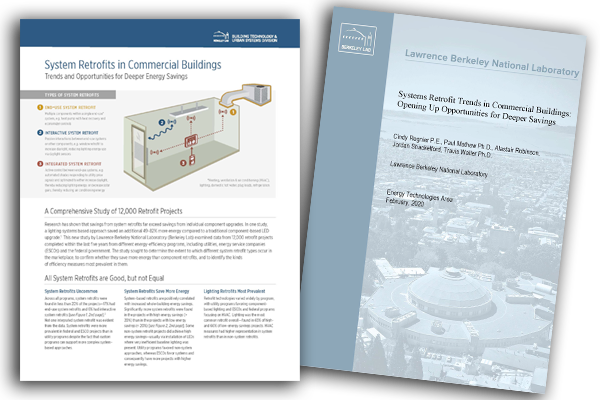Getting Beyond Widgets
Enabling System Retrofits in Utility Incentive Programs
Commercial building retrofits have historically focused on individual building component-level or “widget” upgrades, such as replacing equipment or light fixtures. Accessing deep energy savings in commercial buildings requires a move beyond these equipment- or component-level upgrades, as demonstrated in case studies published in the journals Energy and Buildings and Energies.
Working with utility programs, Berkeley Lab researchers have developed and validated system packages that offer a system-based approach towards energy saving retrofits in commercial buildings. These system packages combine multiple equipment and controls upgrades for energy savings that benefit from interactive effects of the different system elements. Energy savings for the system packages are modeled, and the performance of each package is validated in our FLEXLAB® test facility.
Our team produced Program Manual documents that incorporate the system package test results, and also include system specifications, performance measurement and validation protocols, recommended operating practices, and guidelines for system implementation. This document provides our utility partners with resources to establish a rebate incentive program around the systems packages.
In phases one and two of this project, Berkeley Lab researchers worked with partner utility companies to develop and validate system packages including lighting and lighting controls, partnered with automated shading, and plug load occupancy-based controls, or HVAC controls. Phase is ongoing and involves a partnership with an additional U.S. utility program to examine the integration of HVAC and lighting energy efficiency measures.
System Retrofit Trends Study
In order to better understand how a system-based approach could benefit commercial buildings, we set out to identify to what extent system retrofits are occurring, what technologies are being used, and to what extent they correlate with deeper energy savings. Based on the data, system retrofits are very uncommon in utility programs, but occur at a higher frequency in federal retrofits and ESCO projects. Further, there is a noticeable correlation between projects that adopted system retrofits and those that saved more energy.
The study analyzed data from 12,000 retrofits in commercial buildings sourced from utility custom incentive programs, federal retrofit programs, and ESCO projects.
System Retrofit Trends Study
System Retrofit Trends Study Summary
Implementation Via Utility Programs
Overall, utility incentive programs remain one of the most significant means of deploying commercialized, but underutilized building technologies to scale. This project was funded by the U.S. Department of Energy (DOE) and aims to work with utility companies to establish streamlined specifications, assessment methods, and validated performance for integrated building systems to be implemented under Utility incentive programs nationwide. While these materials are developed for utility program managers and implementers, their content can be used by owners, operators, architects, engineers, and contractors as well.


